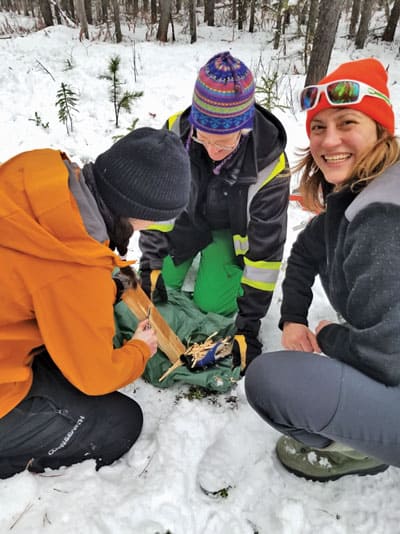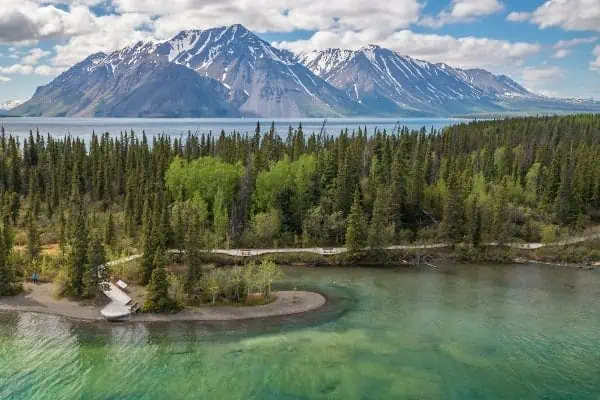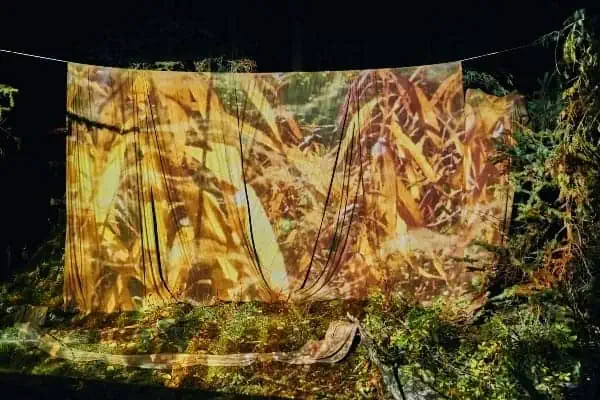James Minifie maintains one of the Yukon region’s remote weather stations. The data provided by these units is used to help produce the avalanche forecast. PHOTO: Jennifer Coulter
If record-breaking snowfalls and COVID-19 cabin fever have you charging for the hills, come to a full-spray stop and make sure you know how to keep yourself, your friends and first responders safe in the backcountry this winter.
Getting into the backcountry is a great way for Yukoners to experience the physical and mental health benefits of being in nature while respecting public health guidelines. With increasing numbers of outdoor recreationalists converging on backcountry spaces in recent weeks, it is more crucial than ever to ensure you have the training, knowledge and equipment to match your adventure plans. Check out these safety tips from three local specialists.
James Minifie is an avalanche field technician with Avalanche Canada, the country’s national public avalanche safety organization. The Yukon field team ensures regular avalanche forecasts are available for the Yukon region, including the White Pass and Wheaton Valley. Minifie has the following advice:
- Get the training: if you’re going into the winter backcountry, you need the skills required to recognize and safely navigate avalanche terrain. An AST 1 (Avalanche Safety Training course, Level 1) is your first step. For a good introduction, check out the new online tutorial at avysavvy.avalanche.ca.
- Get the gear: Everyone in your group needs an avalanche transceiver, probe and shovel. Each group member needs to be well-practiced and familiar with these tools.
- Get the forecast: Check avalanche.ca/forecasts/yukon to get the current danger rating and so much more, including the type of avalanche problems to expect and how to best avoid them.
Jeni Rudisill is Parks Canada’s visitor safety coordinator for Chilkoot Trail National Historic Site. The Chilkoot Trail’s Log Cabin area is a destination and launching spot for winter enthusiasts in the White Pass region. These are Rudisill’s top tips:
- Do your pre-trip planning: Research your objective, route options, and current and forecasted conditions. Ask others who have recently been there and leave a trip plan with someone you trust.
- Be ready for the unexpected: Think about what your group would need for an unexpected night out if something goes wrong. Essentials include extra food and layers, firestarter, first aid kit, whistle, emergency bivy and headlamps. Bring spare parts and tools for your skis/board/sled. A ski guide tarp comes in handy as an improvised rescue toboggan if you need to self-evacuate. Sledders should have sufficient fuel and a tow strap. Ride with a buddy with a reliable sled.
- Make sure your group is aligned: After a backcountry incident, it is common to hear that, in retrospect, some members of the group had concerns, but felt uncomfortable speaking up. Make sure everyone in your group knows the game plan and is up for the adventure. Ensure your objective matches the ability and training of the group. Remember to communicate openly.

Danielle Nadine Daffe is the adventure smart coordinator for Yukon Search and Rescue (SAR). Yukon SAR heads a team of trained volunteers that supports the RCMP during search and rescue operations and other emergencies. Daffe has three recommendations:
- Carry navigation and communication aids and know how to use them: Don’t expect cell phone service in Yukon’s backcountry areas. Maps, compass or GPS, and satellite phone or GPS messenger device with pre-programmed contacts will allow you to call for help in an emergency and accurately communicate your location.
- Stay put: If you get lost, weathered in, or someone gets injured and you can’t self-evacuate, find a safe spot, build a shelter and stay put. Be prepared for delays in rescue response due to weather and/or availability of rescue personnel and aircraft.
- Use signaling devices: Blowing a whistle, lighting a fire and staying visible will help searchers find you.
All three specialists recommend using AdventureSmart resources to get prepared. AdventureSmart is a national program aimed at providing Canadians with the information they need to enjoy the outdoors safely. Visit adventuresmart.ca and download the AdventureSmart app for a convenient way to log your trip plan.
Know before you go and adventure wisely.




